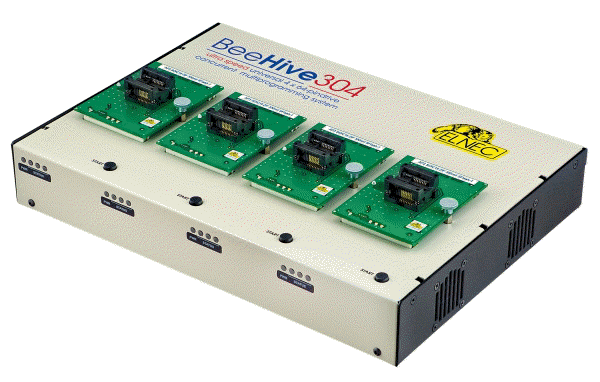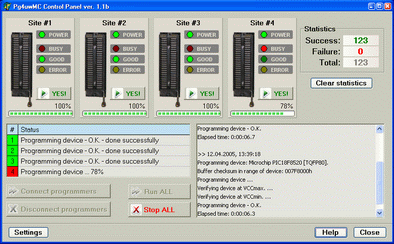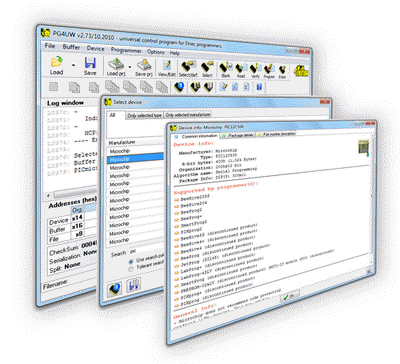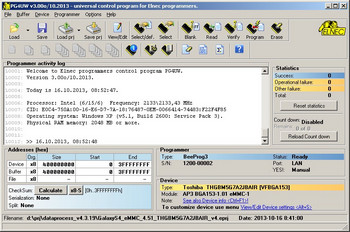|
|
|
BeeHive304
Ultra speed universal 4x 64-pindrive production
multiprogrammer,
the design was focused on high-capacity
memories programming.
|
|

Short description:
- Four independent universal programming modules
BeeProg3 based) in one unit
- the programmer perfectly fits for high-demanding
desktop programming, as well as for automated
programming systems
- based on a state of the art FPGA design, powerful ARM
processor and internal SSD, the BeeHive304 is ready to
program devices at theoretically possible speeds
- 4x 64-pins rich-features, precise and powerful
pindriver provides programming signals for every
technology of programmable devices
- it supports devices with VCC voltages as low as
0.8V
- ultra fast programming speed, one of the fastest
programmers worldwide. Sustainable programming speed greater
than 31 MBytes per second
- the 8 GB eMMC NAND Flash could be done in less
than 250 sec, if supported memory is fast enough
- it utilizes both universal programming modules,
dedicated for IC package type and specialized modules,
designed optimized for specific device families
- ESD protection on each pins of the programming
modules interface (pindriver and also supporting signals)
- dual connection to the PC: USB (2.0 HighSpeed)
and LAN (up to 1 Gbit)
- comfortable and easy to use control program, works with
all versions of MS Windows from Windows XP to Windows 11
(32-bit and 64-bit)
- two BeeHive304 units can be attached to one control PC
to better utilize programming workplace
- implementation into available 3rd party automated
programmers and ATE machines using simple
remote control
- one software can serve up to 64 programming sites
in one automated programmer (16x BeeHive304 programmers)
- unique quick reaction to customer's needs - software
update can be ready within a day from request, by
OnDemand software
-
developed and made in Slovakia
-
warranty - 3 years
Optional accessories:
 Back to top Back to top
GENERAL
BeeHive304 is next member of Elnec concurrent
universal multiprogrammer series, built to meet the strong
demand for an extremely fast and reliable
multiprogrammer for high-capacity memories. Designed with great emphasis on technical perfection and
speed of hardware, this programmer perfectly fits for
high-demanding desktop programming as well as for
automated programming systems and ATE machines, where
ensures the highest quality and overall yield.
BeeHive304 consists of four independent isolated
universal programming sitess, based on the
BeeProg3 programming core hardware. Therefore the
programming sites can run asynchronously (concurrent
multiprogramming programming mode). Each programming site
starts programming at the moment the chip is detected to be
inserted in the socket properly - independently on the status of
other programming sites. As a result, three programming sites
works, while you are replacing the programmed chip at the fourth
site.
The BeeHive304 multiprogrammer supports as many chips, as
the BeeProg3 programmer and without obvious decrease of
programming speed because each programming site works
independently. Also each programming site can program a
different chip, if necessary.
Because the BeeProg3 programming core is based on a
state of the art FPGA, powerful ARM processor and internal SSD,
BeeHive304 is ready to program devices at theoretically possible
speeds. The achieved ultra fast programming speed - more
than 31 MB/s sustainable - is actually higher, than can be
utilized for most of real devices. This is reflected in
extremely short programming times. For example, the 8 GB
eMMC NAND Flash could be done in less than 250 sec - if
programmed memory allow that speed.
Tests show, that the BeeHive304 is currently faster than all
competitors in this price category (status: 10/2015), and for
many chips is the fastest at all.
BeeHive304 supports all kinds of types and silicon
technologies of today's and tomorrow's programmable devices.
It partially supports also devices "from yesterday". You can be
sure the next devices support will require the software update
only, at the most (if necessary) simple programming module,
therefore the costs of ownership is minimized.
For the proper and reliable programming of ultra-fast
memories the BeeHive304 utilizes specialized modules,
optimally designed for specific device families, exactly
according to the needs of programmed devices. But if it is
possible, then universal programming modules, dedicated for IC
package type, are used. The programming modules are identical
for all programmers based on the BeeProg3 programming core.
Programming modules construction is designed for perfect
stability at the top of the programmer, to be tough enough
for insert/replace chips by mechanical arm and also allows to
keep identical position of ZIF socket also after replacing of
the module.
Modular construction of hardware - the programming sites
works independently - allows for continuous operation when a
part of the programming sites becomes inoperable. It also makes
service quick and easy.
The sensing circuits detect proper placement of device in
the socket of programming module, which allows to begin
programming immediately upon insertion of a chip. The
operator merely removes the finished chip and inserts a new
chip. Operator training is therefore minimized.
BeeHive304 interfaces with any IBM PC compatible personal
computers, running MS Windows OS, through USB (2.0
HigSpeed) port or LAN port (up to 1 Gb).
Banana jack for ESD wrist straps connection to
easy-to-implement the ESD protection control.
With its very competitive price together with excellent
hardware design for reliable programming, it is probably the
best "value for money" programmer in this class.
 Back to top Back to top
HARDWARE
(valid for each programming module)
The 64-pin rich-features, precise and powerful pindriver
of BeeProg3 programming core deliver high speed, accurate and
clean waveform signals to the device by eliminating noise,
ground bounce and overshoot, which maximizes programming yield
and guarantees long data retention. This also allows the
reliable support of virtually any nonvolatile technology used
for programmable devices - (E)EPROM, Flash, MRAM, PCM, ... - by
a single device programmer.
FPGA based totally reconfigurable TTL pindrivers provide
H/L/pull_up/pull_down and read capability for each pin of the
device. The dual H/L drivers enables to provide two different H
levels for both core signals and I/O signals of programmed
device without additional logic. Programmer pindrivers operate
down to 0.8V, therefore the programmer is ready to program the
full range of today's and tomorrow's advanced very-low-voltage
devices.
Extremely fast programming, achieved by using FPGA based
state machine, fast processor and SSD, allow execution of all
time-critical routines and data transfers inside of the
programmer.
The programmer performs a device insertion test (wrong or
backward position) and contact check (poor contact
pindriver-to-socket) before it programs each device. These
capabilities, supported by overcurrent protection and
signature-byte check help prevent chip damage due to
operator error.
The selftest capability allows to run the diagnostic part of
software to thoroughly check the health of the programmer.
Built-in protection circuits eliminate damage of
programmer and/or programmed device due to environment or
operator failure. All the inputs of the BeeProg3 programming
core - pins of programming modules interface (pindriver signls
and also supporting signals), connection to PC and power supply
input, are protected against ESD up to 15kV.
The programming modules are available for devices in
PDIP, PLCC, JLCC, SOIC, SDIP, SOP, PSOP, SSOP, TSOP, TSOPII,
TSSOP, QFP, PQFP, TQFP, VQFP, QFN (MLF), SON, BGA, EBGA, FBGA,
VFBGA, UBGA, FTBGA, LAP, CSP, SCSP, LQFP, MQFP, HVQFN, QLP, QIP
and other packages.
 Back to top Back to top
SOFTWARE
(production mode control SW: PG4UWMC)
This part of the software is focused to the easy monitoring of high-volume production operations.
Operator-friendly control software combines many powerful functions with ease of use. Graphic user interface provide overview of all important activities result without burden of operator with non-important details.

There is used a project file to control the BeeHive304 multiprogramming system. Project file contains user data, chip programming setup information, chip configuration data, auto programming commund sequence, etc. Therefore the
operator error is minimized, because the project file is normally created
und proofed by engineering und then given to the operator. The optional
protected mode can be set for project file to
avoid a unwanted changes of the project file.
Each chip may be programmed with different data such as
serial number, configuration and calibration information
using rich-features serialization system.
|
 Back to top Back to top
SOFTWARE (programming
modules driver, engineering mode control SW: PG4UW)
This part of the software is focused to the quick und easy preparation of the project file for usage in the production mode control software.
Each programming module is driven by an easy-to-use control program with pull-down menu, hot keys
und on-line help. Selecting of device is performed by its class, by manufacturer or simply by typing a fragment of vendor name
und/or part number. It is the same years-proven software, as is used for all other Elnec single-site programmers.
Selecting of device is performed by its class, by manufacturer or simply
by typing a fragment of vendor name and/or part number. Standard
device-related commands (read, blank check, program, verify, erase) are
boosted by some test functions (insertion test, signature-byte
check), and some special functions (autoincrement, production
mode - start of programming immediately after insertion of chip into
socket).
 
All known data formats are supported. Automatic file format
detection and conversion during loading of file.
The software also provides - in the Device information section -
lots of information about the programmed device. As a special, the
drawings of all available packages are provided. The software also
provides explanation of chip marking (the meaning of prefixes and
suffixes at the chips) for each supported chip.
The rich-featured serialization function enables one to
assign individual serial numbers to each programmed device - or simply
increments a serial number, or the function enables one to read serial
numbers or any programmed device identification signatures from a file
and program it to programmed device.
Jam files of JEDEC standard JESD-71 are interpreted by Jam
Player. Jam files are generated by design software which is provided
by the manufacturer of respective programmable device. Chips are
programmed through JTAG (IEEE 1149.1 Joint Test Action Group) interface.
VME files are interpreted by VME Player. VME file is a
compressed binary variation of SVF file and contains high-level IEEE
1149.1 bus operations. SVF files are interpreted by SVF Player. SVF file
(Serial Vector Format) contains high-level IEEE 1149.1 bus operations.
SVF files are generated by design software which is provided by
manufacturer of respective programmable device. Chips are programmed
through JTAG interface. VME files are generated by design software which
is provided by manufacturer of respective programmable device.
 Back to top Back to top
Implementation into automated programming
systems
- BeeHive304 programmer is ready for usage in the automated
programming systems. The dimensions of programmer are reduced to
technical minimum for this features&quality hardware in intent to
minimize overhead of the handler's arm movement. The construction is
mechanically stable to be immune against vibration during operation.
The case of BeeHive304 is prepared to be fastened from top or from
bottom of programmer body into automated programmer working place.
- The BeeHive304 can be implemented into automated
programmer (as a replacement of obsolete programmer for example) or
into some handler using more ways:
- 1) if one or two BeeHive304 programmers are enough to
do all job, then is enough to use one control PC for whole
programming system, for both machine control and also programmer
software. The BeeHive304 can be attached to this computer using
USB or LAN port.
- 2) if more than two BeeHive304 programmers is
necessary to implement into automated programmer, then more
computers are necessary to use. Whole system is scalable up
to 64 programming sites in one automated programming system
by multiplying of BeeHive304 programmers and the control PCs.
Maximal configuration comprise of 16x BeeHive304
programmers. One control computer in the system serve as a
master unit. Here is running also multiprogramming control
software, serialization engine and interface to the host system.
Interfacing of control PCs in whole network is done over
standard LAN.
- Implementation of BeeHive304 into software of automated
programmers and handlers is by using of simple remote
control of the PG4UWMC control software. There exist examples of
implementation for standard programming languages and of course we
are ready to help customer with this task.
CARE FOR THE CUSTOMERS
New Device Request
AlgOR Service
- It is important to remember, that a support of most
of the new devices requires only a software update,
because the BeeProg304 is truly a universal programmer.
With our prompt service, support for the new device can
be added within a hours. See
AlgOR (Algorithm On Request) service and
OnDemand software for details.
This service is in almost all cases free. Please
note, however, that we can ask the customer to share the
costs, if development and manufacturing costs are too
high.
Free life-time
software
updates
Most current version of Elnec programmers software,
with support of newly added devices, is available for
free
here.
Free
Technical support
- Elnec provide customers technical support
(WebForm/e-mail based) available usually within a few
hours, or at the latest, the next working day.
Keep-Current service
-
Keep-Current service means, that Elnec ships the
latest version of programmer software and updated user
documentation (Keep-Current package) to the customer .
The Keep-Current service is your hassle-free guarantee
that you are achieving the highest quality programming
on Elnec programmers, at minimal cost.
Prompt delivery
- Combination of extensive stock, flexible
manufacturing and shipping of Elnec products by world
class carriers (like DHL) guarantees customers very fast
and secure delivery of ordered Elnec products. Products
ordered before 10 a.m. (CET) will be dispatched the same
working day - if products are in stock and the payment
is done by Online payment (CardPay, PayPal).
Warranty
- Advanced design of the BeeProg304 universal
programmer, including protective circuits, original
brand components, careful manufacturing and burning-in
allow us to provide a three-year warranty on
parts and workmanship of the programmer and programming
adapters with limited warranty on ZIF sockets according
to information about the maximal actuations number of
the particular ZIF socket.
Elnec provides free shipping of programmer
repaired under warranty back to customers worldwide.
The warranty is valid from the date of purchase.
- Preferential handling of repair requests ensures
registration of the product that should be done within
60 days from the date of purchase
here.
Specification (BeeHive304
multiprogramming system)
- 4x universal programming sites (4x BeeProg3 programming core)
- operation result LEDs, LED power
- USB 2.0 high-speed compatible port, LAN port
- line power input 100-240VAC/90W max.
- protection against surge and ESD on all inputs (power,
communication, programming module interface)
- banana jack for ESD wrist straps connection
- banana jack for connection to ground
 Back to top Back to top
Specification (valid for each programming site)
HARDWARE
Base unit, DACs
- USB 2.0 high-speed compatible port, up to 480 Mbit/s transfer
rate
- 100Mbit LAN port
- on-board intelligence: powerful processor (ARM9 400MHz) and FPGA
based state machine (basic clock 50 MHz plus PLLs)
- built-in mSATA SSD as internal buffer (32GB type, upgradeable to
higher capacity)(*1, *2, *3)
- three D/A converters for VCC1, VCC2, and VPP, controllable rise
and fall time
- VCC1, VCC2 range 0.8V..7V/1A (step 10mV)
- VPP range 0V..25V/1A (step 25mV)
- Temperature controlled fans
- selftest capability
- protection against surge and ESD on power supply input, USB and
LAN port and pins of programming module interface (PMI)(IEC1000-4-2:
15kV air, 8kV contact)
- banana jack for ESD wrist straps connection
- screw with two washers for connection to ground
Notes:
- *1: the data in the buffer are stored in fragments and also
partially compressed, therefore the buffer can keep standard data
also for bigger size devices, than current size of the buffer
- *2: this upgrade is mechanically complicated and can be done
at Elnec only
- *3: the 32GB SSD can store as a buffer roughly 28 GB of the
random data, the bigger sizes SSD, proportionally. If you plan to
work/copy eMMC/NAND device, which might contain random data in full
range of the device size, we recommend to have equal capacity buffer
in the programmer.
HARDWARE
Base unit, DACs
- USB 2.0 high-speed compatible port, up to 480 Mbit/s transfer
rate
- 100Mbit LAN port
- on-board intelligence: powerful processor (ARM9 400MHz) and FPGA
based state machine (basic clock 50 MHz plus PLLs)
- built-in mSATA SSD as internal buffer (32GB type, upgradeable to
higher capacity)(*1, *2, *3)
- three D/A converters for VCC1, VCC2, and VPP, controllable rise
and fall time
- VCC1, VCC2 range 0.8V..7V/1A (step 10mV)
- VPP range 0V..25V/1A (step 25mV)
- Temperature controlled fans
- selftest capability
- protection against surge and ESD on power supply input, USB and
LAN port and pins of programming module interface (PMI)(IEC1000-4-2:
15kV air, 8kV contact)
- banana jack for ESD wrist straps connection
- screw with two washers for connection to ground
Notes:
- *1: the data in the buffer are stored in fragments and also
partially compressed, therefore the buffer can keep standard data
also for bigger size devices, than current size of the buffer
- *2: this upgrade is mechanically complicated and can be done
at Elnec only
- *3: the 32GB SSD can store as a buffer roughly 28 GB of the
random data, the bigger sizes SSD, proportionally. If you plan to
work/copy eMMC/NAND device, which might contain random data in full
range of the device size, we recommend to have equal capacity buffer
in the programmer.
Pindriver (available on the Programming Module Interface (PMI) -
connectors for programming modules)
- pindrivers: 64 universal
- VCC1/VCC2 and VPP can be connected to each pin
- perfect ground for each pin
- 2 independent FPGA based TTL driver provides H, L, CLK, pull-up,
pull-down on all pindriver pins, logic level 0,75V - 5V (IOL and IOH
current 20mA)
- logic signals frequency: up to 125MHz (3.3V), 80MHz (5V)
- analog pindriver output level selectable from 0.8 V up to 25V
- current limitation, overcurrent shutdown, power failure shutdown
- continuity test: each pin is tested before every programming
operation
 Back to top Back to top
DEVICE SUPPORT
Programmer, using programming modules:
- NAND FLASH: Samsung K9xxx, KFxxx, SK Hynix (ex Hynix) HY27xxx,
H27xxx, Toshiba TC58xxx, TH58xxx, Micron MT29Fxxx, (ex Numonyx ex
STM) NANDxxx, Spansion S30Mxxx, S34xxx, 3D-Plus 3DFNxxx, ATO
Solution AFNDxxx, Fidelix FMNDxxx, Eon Silicon Sol. EN27xxx, ESMT
F59xxx, LBA-NAND Toshiba THGVNxxx
- serial NAND FLASH: Micron MT29Fxxx, GigaDevice GD5Fxxx
- eMMC: Hynix H26Mxxxxxxxx, Kingston KE44B-xxxx/xxx, Micron
MTFCxxxxxx, Numonyx NANDxxxxxxxx, Phison PSM4A11-xx, Samsung
KLMxxxxxxx, SanDisk SDINxxx-xx, Toshiba THGBMxxxxxxxxxx
- eMCP: eMMC+RAM
- Memory Cards: MMC, SD, SDHC, SDXC
- Multi-chip devices: NAND+RAM, NOR+RAM, NOR+NOR+RAM, NAND+NOR+RAM
- Serial Flash: standard SPI, high performance Dual I/O SPI and
Quad I/O SPI (25Bxxx, 25Dxxx, 25Exxx, 25Fxxx, 25Lxxx, 25Mxxx,
25Pxxx, 25Qxxx, 25Sxxx, 25Txxx, 25Uxxx, 25Vxxx, 25Wxxx, 25Xxxx,
26Vxxx, 45PExx, MX66Lxxx, S70FLxxx), DataFlash (AT45Dxxx, AT26Dxxx)
- parallel NOR Flash: 28Fxxx, 29Cxxx, 29Fxxx, 29GLxxx, 29BVxxx,
29LVxxx, 29Wxxx, 49Fxxx series, Samsung's K8Fxxxx, K8Cxxxx, K8Sxxxx,
K8Pxxxx series, ...
- Serial E(E)PROM: Serial E(E)PROM: 11LCxxx, 24Cxxx, 24Fxxx,
25Cxxx, 30TSExxx, 34Cxxx, 34TSxx, 59Cxxx, 85xxx, 93Cxxx, NVM3060,
MDAxxx series, full support for LV series, AT88SCxxx
- Serial FRAM: Cypress(Ramtron): FM24xxxxxx, FM25xxxxxx, Fujitsu:
MB85RCxxxx, MB85RSxxxx, Lapis(OKI, Rohm): MR44xxxxx, MR45xxxxx
- Configuration (EE)PROM: XCFxxx, XC17xxxx, XC18Vxxx, EPCxxx,
EPCSxxx, AT17xxx, AT18Fxxx, 37LVxx
- PLD Altera: MAX 3000A, MAX 7000A, MAX 7000B, MAX 7000S,
MAX7000AE, MAXII/G/Z, MAX V
- PLD Lattice: ispGAL22V10x, ispLSI1xxx, ispLSI1xxxEA, ispLSI2xxx,
ispLSI2xxxA, ispLSI2xxxE, ispLSI2xxxV, ispLSI2xxxVE, ispLSI2xxxVL,
LC4xxxB/C/V/ZC/ZE, M4-xx/xx, M4A3-xx/xx, M4A5-xx/xx, M4LV-xx/xx,
ispCLOCK, Power Manager/II, ProcessorPM
- PLD Xilinx: XC9500, XC9500XL, XC9500XV, CoolRunner XPLA3,
CoolRunner-II
- SPLD/CPLD series: AMD, AMI, Atmel, Cypress, Gould, ICT, Lattice,
National Semicond., Philips, STMicroelectronics, TI (TMS), Vantis,
VLSI
- FPGA: Lattice: MachXO, MachXO2, LatticeXP, LatticeXP2, ispXPGA
- FPGA: Microsemi(Actel): ProASIC3, IGLOO, Fusion, ProASICplus,
SmartFusion
- Microcontrollers Atmel ARM AT91SAM7Sxx, AT91SAM7Lxx,
AT91SAM7Xxx, AT91SAM7XCxx, AT91SAM7SExx series;
- Microcontrollers Atmel ARM9: AT91SAM9xxx series;
- Microcontrollers Microchip PICmicro: PIC10xxx, PIC12xxx,
PIC16xxx, PIC18xxx, PIC24xxx, dsPIC, PIC32xxx series
- Microcontrollers Motorola/Freescale: S12, MCF52 series
(ColdFire), MC56F, Kinetis (K,L), Qorivva/5xxx Power Architecture
- Microcontrollers NEC: uPD70Fxxx, uPD78Fxxx series
- Microcontrollers Nordic Semiconductor: nRF24LExxx, nRF24LUxxx,
nRF315xx, nRF51xxx Flash and OTP series
- Microcontrollers Nuvoton ARM Cortex-Mx: NUC1xx, NUC2xx, M05x,
Mini51, Nano1xx series
- Microcontrollers Nuvoton (Winbond): N79xxx, W77xxx, W78xxx,
W79xxx, W83xxx series
- Microcontrollers NXP (Philips) UOC series: UOCIII, UOC-TOP,
UOC-Fighter (TDA1xxxx) series
- Microcontrollers Renesas: R8C/Tiny series, RX series, uPD70Fxxx,
uPD78Fxxx series, RL78 series, R32C series
- Microcontrollers Silicon Laboratories(Energy Micro): EFM32Gxx,
EFM32GGxx, EFM32LGxx, EFM32TGxx, EFM32WGxx series
- Microcontrollers Silicon Laboratories: SiM3Cxxx, SiM3Lxxx,
SiM3Uxxx series
- Microcontrollers STM (ex SGS-Thomson): SPC5 (Power Architecture)
- Microcontrollers TI (Chipcon): CC11xx, CC24xx, CC25xx, CC85xx
series
-
--- we're currently working on the supportof devices mentioned below this line ---
-
- EPROM: NMOS/CMOS, 27xxx and 27Cxxx series
- EEPROM: NMOS/CMOS, 28xxx, 28Cxxx, 27EExxx series, 3D Plus
3DEExxxxxxxx
- FRAM: Ramtron
- MRAM: Everspin MRxxxxx8x, 3D Plus 3DMRxxxxxxxx
- NV RAM: Dallas DSxxx, SGS/Inmos MKxxx, SIMTEK STKxxx, XICOR
2xxx, ZMD U63x series
- mDOC H3: SanDisk (ex M-Systems) SDED5xxx, SDED7xxx, MD2533xxx,
MD2534xxx, Hynix HY23xxx
- Serial MRAM: Everspin MH20xxx, MH25xxx
- 1-Wire E(E)PROM: DS1xxx, DS2xxx
- FPGA: Xilinx: Spartan-3AN
- Clocks: TI(TMS), Cypress
- Special chips: Atmel Tire Pressure Monitoring ATA6285N,
ATA6286N; PWM controllers: Zilker Labs, Analog Devices; Multi-Phase
ICs: IR(Chil Semiconductor); Gamma buffers: AUO, Maxim, TI, ...
- Microcontrollers MCS51 series: 87Cxxx, 87LVxx, 89Cxxx, 89Sxxx,
89Fxxx, 89LVxxx, 89LSxxx, 89LPxxx, 89Exxx, 89Lxxx, all
manufacturers, Philips LPC series
- Microcontrollers ARM Cortex-M3: ATSAM3Axxx, ATSAM3Uxxx,
ATSAM3Nxxx, ATSAM3Sxxx, ATSAMD20, ATSAM3Xxxx series
- Microcontrollers ARM Cortex-M4: ATSAM4Sxxx series
- Microcontrollers Atmel AVR 8bit/16bit: AT90Sxxxx, AT90pwm,
AT90can, AT90usb, ATtiny, ATmega, ATxmega series
- Microcontrollers Atmel AVR32: AT32UC3xxxx, ATUCxxxD3/D4/L3U/L4U
series
- Microcontrollers Coreriver: Atom 1.0, MiDAS1.0, 1.1, 2.0, 2.1,
2.2, 3.0 series
- Microcontrollers Cypress: CY7Cxxxxx, CY8Cxxxxx
- Microcontrollers ELAN: EM78Pxxx
- Microcontrollers EPSON: S1C17 series
- Microcontrollers Explore Microelectronic: EPF01x, EPF02x series
- Microcontrollers Generalplus: GPM8Fxxx series
- Microcontrollers GreenPeak: GPxxx series
- Microcontrollers Infineon(Siemens): XC800, C500, XC166, C166
series
- Microcontrollers MDT 1xxx and 2xxx series
- Microcontrollers Megawin: MG87xxx, MPC82xxx series
- Microcontrollers Motorola/Freescale: HC05, HC08, HC11, HC12,
HCS08, RS08, S12X, MCF51
- Microcontrollers Myson MTV2xx, 3xx, 4xx, 5xx, CS89xx series
- Microcontrollers National: COP8xxx series
- Microcontrollers Novatek: NT68xxx series
- Microcontrollers NXP (Philips) ARM Cortex-Mx: LPC11xx, LPC11Cxx,
LPC11Dxx, LPC11Uxx, LPC12xx, LPC12Dxx, LPC13xx, LPC17xx, LPC11Axx,
LPC11Exx, LPC11xxLV, LPC18xx, LPC43xx, LPC8xx, EM7xx, series
- Microcontrollers NXP (Philips) ARM7: LPC2xxx, MPT6xx, PCD807xx,
SAF7780xxx series
- Microcontrollers NXP (Philips) ARM9: LPC31xx series
- Microcontrollers SyncMOS: SM39xxx, SM59xxx, SM73xxx, SM79xxx,
SM89xxx series
- Microcontrollers STM (ex SGS-Thomson): ST6xx, ST7xx, ST10xx,
STR7xx, STR9xx, STM32F/L/W, STM8A/S/L series
- Microcontrollers Silicon Laboratories(Cygnal): C8051 series
- Microcontrollers Texas Instruments: MSP430 series, MSC12xx
series, TMS320F series, CC430 series,
- Microcontrollers Texas Instruments (ex Luminary Micro): LM3Sxxx,
LM3Sxxxx series, LM4Fxxxx series, TM4C series
- Microcontrollers ZILOG: Z86/Z89xxx and Z8Fxxxx, Z8FMCxxxxx,
Z16Fxxxx, ZGP323xxxxxx, ZLF645xxxxxxx, ZLP12840xxxxx, ZLP323xxxxxxx
series
- Microcontrollers other: EM Microelectronic, Spansion(Fujitsu),
Goal Semiconductor, Hitachi, Holtek, Novatek, Macronix, Princeton,
Winbond, Samsung, Toshiba, Mitsubishi, Realtek, M-Square, ASP,
Coreriver, Gencore, EXODUS Microelectronic, Topro, TinyARM,
VersaChips, SunplusIT, M-Square, QIXIN, Signetic, Tekmos, Weltrend,
Amic, Cyrod Technologies, Ember, Ramtron, Nordic Semiconductor,
Samsung, ABOV Semiconductor...
Notes:
for all supported devices see
DEVICE LIST
Package support
- package support includes DIP, SDIP, PLCC, JLCC, SOIC, SOP, PSOP,
SSOP, TSOP, TSOPII, TSSOP, QFP, PQFP, TQFP, VQFP, QFN (MLF), SON,
BGA, EBGA, FBGA, VFBGA, UBGA, FTBGA, LAP, CSP, SCSP, LQFP, MQFP,
HVQFN, QLP, QIP etc.
 Back to top Back to top
Programming speed
Notes:
- It is important to say, we always use random numbers data
pattern for programming speed testing. Some our competitors use
"sparse" data pattern, where only small amount
 of non-blank data are programmed or there are used data with only
few 0 bits (FE, EF, etc.). This cheating approach can "decrease"
programming time considerably. If you plan to compare, ask always
which pattern they use.
of non-blank data are programmed or there are used data with only
few 0 bits (FE, EF, etc.). This cheating approach can "decrease"
programming time considerably. If you plan to compare, ask always
which pattern they use.
- The programming speed practically doesn't depend on PC type
because data for programming and main part of programming algo are
stored internally inside of the programmer.
- All devices mentioned below, including both NAND Flash, are
programmed at their maximal speed, the programming time can not be
shorter.
- Currently exist not very much devices, where the 30+ MB/s
BeeHive304 programming speed can be utilized.
| Device |
Size [bits] |
Operation |
Time |
| JS28F00AM29EWH (parallel NOR Flash) |
|
4000080hx16 (1 Giga) |
programming + verify |
116 sec. |
| MT29F1G08ABAEAWP
(parallel NAND Flash) |
8400000Hx8 (1 Giga) |
programming + verify |
20.6 sec. |
| SDIN8DE2-8G (eMMC NAND
FLASH) |
1D2000000hx8 (64 Giga) |
programming *1 |
269 sec. |
| S25FL164K (serial
Flash) |
800300hx8 (64 Mega) |
programming + verify |
20.5 sec. |
| AT89LP51RD2
(microcontroller) |
10000hx8 |
programming + verify |
5.2 sec. |
| PIC32MX360F512L (microcontroller) |
80000hx8 |
programming + verify |
8.9 sec. |
*1: Verification of programming
is done by internal controller of eMMC device. The device
receives a block of data plus CRC, if it all matches, the
internal controller confirm the proper programming.
Conditions: PC type: Core2 Duo, 3.16 GHz, 1G RAM, USB
2.0 HS, Windows 7. Version of SW: 3.09, 10/2014.
SOFTWARE
- Algorithms: only manufacturer
approved or certified algorithms are used. Custom algorithms are
available at additional fee.
- Algorithms updates: software updates are available regulary, approx. every 4 weeks,
free of charge. OnDemund version of software is available
for highly needed chips support und/or bugs fixes. Available
nearly daily, depnding of request.
- Main features: revision history,
session logging, on-line help, device und algorithm information.
Device operations
- standard:
- intelligent device selection by device type, manufacturer or
typed fragment of part name
- blank check, read, verify
- program
- erase
- configuration and security program
- checksum
- interpret the Jam Standard Test and Programming Language
(STAPL), JEDEC standard JESD-71
- interpret the VME files compressed binary variation of SVF
files
- interpret the SVF files (Serial Vector Format)
- interpret the Actel STAPL Player files
- security
- insertion test
- contact check
- ID byte check
- special
- production mode (automatic start immediately after device
insertion)
- multi-project mode
- lot of serialization modes (more type of incremental modes,
from-file mode, custom generator mode)
- statistic
- count-down mode
Buffer operations
- view/edit, find/replace
- fill/copy, move, byte swap, word/dword split
- checksum (byte, word)
- print
File load/save
automatic file type identification/recognition
Supported file formats
- unformatted (raw) binary
- HEX: Intel, Intel EXT, Motorola S-record, MOS, Exormax,
Tektronix, ASCII-SPACE-HEX,, ASCII HEX
- Altera POF, JEDEC (ver. 3.0.A), eg. from ABEL, CUPL, PALASM,
TANGO PLD, OrCAD PLD, PLD Designer ISDATA, etc.
- JAM (JEDEC STAPL Format), JBC (Jam STAPL Byte Code), STAPL
(STAPL File) JEDEC standard JESD-71
- VME (ispVME file VME2.0/VME3.0)
- SVF (Serial Vector Format revision E)
- STP (Actel STAPL file)
 Back to top Back to top
GENERAL
PC system requirements
Common, software related requirements
Programmer hardware related requirements:
- either one USB port, 2.0 compatible
- or one LAN port
Operations
- operating voltage 100-240V
AC rated, 90-264 VAC max., 47 63Hz. Output voltage: 15V, 6A,
output cable length 120 cm (47.2 inch)
- power consumption max. 90W active
- dimensions of BeeHive304 programmer: 320,5 x 205
x 58,4 mm ( 12,6 x 8,1 x 2,3 inch).
Dimensions
were measured without programming module inserted and does
not include projections. Total height of BeeHive304
programmer with programming module inserted depends on
height of ZIF socket on the module and can vary between
76-88 mm.
- weight of programmer without programming modules: 3.6kg
(7.9 lb)
- operating temperature: 5°C ÷ 40°C (41°F ÷ 104°F)
- operating humidity: 20%..80%, non condensing
Package includes (programmer and standard accessories):
Bonus pack:
Additonal service
-
Keep Current - ELNEC sends to user a latest version of programmer software
und updated user documentation (Keep-Current package)
-
AlgOR - (Algorithm On Request) - add new supported devices on customer request
Prices: BeeHive304 € 6.640,00
Programmer price also includes
- free technical support(hot line)
- free life-time software via internet
The information in this document are subject to change without notice.
 Back to top Back to top
|

 Back to top
Back to top
 Back to top
Back to top
 Back to top
Back to top
 Back to top
Back to top